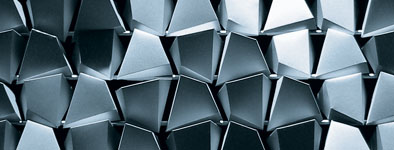Flare Facades: Modular Kinetic Membranes
Image courtesy k-punk.abstractdynamics.org
WHITEvoid has developed a modular system for building facades that also communicates information, albeit more subtly than through the application of buttons and patches. “Acting like a living skin, it allows a building to express, communicate and interact with its environment. FLARE turns the building facade into a penetrable kinetic membrane, breaking with all conventions of the building surface as a static skin” (WHITEvoid.com).

Image courtesy www.flare-facade.com
A modular array of tiltable “metal flake bodies,” each tilted and adjusted by its own set of pneumatic cylinders, can be mounted on any building or wall surface. Various surface animations can be programmed into the system, which is controlled by a computer that can also take information from sensor systems inside and outside the building to create patterns. Think of each flake as a pixel: when in the vertical position, the metal surface of the flake reflects light. When the computer tells the cylinders to tilt a flake downwards, its face is shaded from the sky light and appears dark.
Images courtesy www.flare-facade.com
I think it would be interesting to add artificial light to the product (it needs a few more pieces of flair) – but then again I always want to add LED’s to everything, even when it’s not appropriate. I’m also wondering how CRAZY expensive a facade like this would be – and how have they accounted for maintenance/replacement of parts?
WU XING:
FLARE is metal because it’s a metal skin, but I’m also classifying it as water because it can ripple and move in a watery kind of way.
Special thanks to Nick McWhirter for the heads up – check out his AMAZING photography here: http://redblank.com/dm





















All those little pistons seem like a maintenance nightmare. I do like the idea of integrating occupancy and light sensors with this inside the building, so the ripple effect would occur if one person walked down the perimeter of the building, for instance. If there were an emergency in the building and people were running all over the place, it would show from the outside, like a big spasm.
The picture reminds me of the back of a Sparklett’s water truck.
Leave a Wordpress Comment:
Ads
Watch ARCHITERIALS Videos on vimeo
Like on Facebook
Twitter
Flickr
Hit Counter
Ads
Blogs
Green
Journals/Publications
Materials
Network/News
Offices/People
Resources
Science
Pages
Archive
RSS and Email Subscriptions
Tag Cloud
3D 3D printer AB FAB academic acid acrylic actuated matter adaptive adhesive adsorption aerogel air air conditioning alloy aluminum amnh antibacterial antifungal ants april fool's architecture architecture robot artificial skin autonomous aviation awesome bacteria bamboo bananas beer bench bend bending biennale biocomputing biodegradable biodegradeable biomaterials biomimetics biomimicry biominerals biopolymer birds blast blast-resistant block blocks blogs Bloom Box brazil brick bubbles bucky bulk metallic glass butterfly calera canvas carbon carbon fiber carbon nanotubes carpet cars ceiling cellulose cement ceramic chain link chair charcoal charlie sheen chemicals chiller clay cloth cloud cmu coils color color-changing communication compound computer concrete condensation conducting conductive context cool coral cracks crystal cyborg demakersvan design digifab dirt disaster dna dror drywall dutch dynamic EAP earth ecocradle ecolect e coli ecology ecoresin ecovative elastic electric electricity electrochromic electroluminescent electronic energy energy recovery environment evaporative cooling experiment fabric fabrication facade fiber fiberglass fiber optic fiber optics fibers film FIRE flexible flickr fly ash foam fungus furniture garbage gel geodesic dome geometry gfrp gilgamesh glass glass fiber glow glue gold graphene green greensulate gsapp gypsum hard heat heavy heidi klum helix hemp hexagon hidden high performance hive honeybee humidity ice India ink insulation interference Internet inventables invisible invisible ink jello jellyfish just add water kevlar kinetic korea lace lamboo laser lattice leaves LED leed LEGO light light emitting light transmitting liquid lo mein london Loop.pH machines magic magnetic marine material materials meatball melting memory metabolic engineering METAL metal panel metamaterial micro microsensor microtools military milk MIT moisture multi-layer mushrooms mycelium nano nanogel nanotech nanotubes NASA new noise non-metallic oil OLED OMA ostrich oysters packaging paint panel panels paper paperfoam paraffin wax particles particulates petroleum phase change phosphorescent pink PLA plastic platinum pm-10 poetry pollution polymer polymers porcelain power precast printed printing protein public quadror radiant rain rammed earth reclaimed recycled reflective refracting Rem Koolhaas resin robot robotics roof rubber rugged sand sealant sealer search segmented self-healing sensor shape memory silica silicon silk skin skittles slats smog soft solar solar cell solar cells solar paint solid solid state lighting sound spider spider glue spray stabilized sand stone stretch stretchable strong structural structure studio dror sun sunglasses super supercritical sustainable switzerland tags tape technology TED tensile TEXAS textile textiles texture thermal thermochromatic thin thin film thread tiger stone tile tiles timber tio2 tires toaster tokujin yoshioka touch touch-sensitive toxic transparent t shirts tulip ultra-thin university of akron university of connecticut upcycling virus voc wall wallpaper WATER web wet whale wires WOOD woodwool wool workshop
WP Cumulus Flash tag cloud by Roy Tanck and Luke Morton requires Flash Player 9 or better.
Recent Comments
Ads